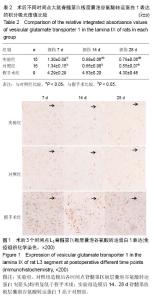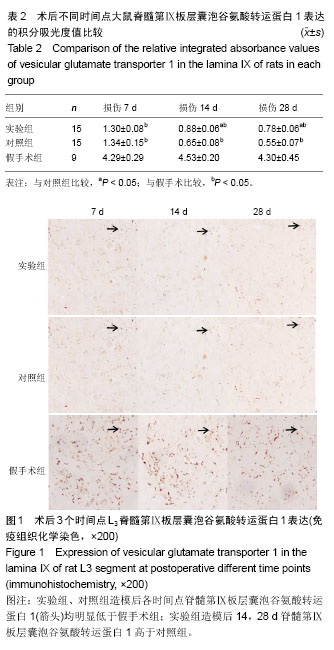| [1] 徐筑秋,杨晓楠,祁佐良.细胞自噬在周围神经损伤及再生中研究进展[J]. 中国修复重建外科杂志, 2017,31(1):122-125.[2] 郑陈帆,刘艳成,闫松华,等. 坐骨神经痛患者的步态特征[J]. 医用生物力学, 2016, 31(1):73-77.[3] 章明星,郭义,刘健卫,等.周围神经损伤研究进展[J].解剖科学进展, 2016,22(3):347-350.[4] Rodríguez FJ,Valero-Cabré A,Navarro X.Regeneration and functional recovery following peripheral nerve injury. Drug Discovery Today Disease Models.2004;1(2):177-185. [5] Castillo-Galván ML,Martínez-Ruiz FM,de la Garza-Castro O,et al.Study of peripheral nerve injury in trauma patients. Gac Med Mex.2014;150(6): 527-532. [6] Berrocal Y,Pearse DD,Singh A,et al.Social and environmental enrichment improves sensory and motor recovery after severe contusive spinal cord injury in the rat. J Neurotrauma. 2007;24(11):1761-1772.[7] 董英,徐昂,姜影,等. 运动训练结合针刺对坐骨神经损伤大鼠肌力和神经纤维恢复的影响[J].滨州医学院学报, 2016, 39(5): 327-329.[8] 刘玉璞,国海东,罗志荣,等. miRNA-21在周围神经损伤和修复中的调控作用[J].生理科学进展,2017,48(1):69-72.[9] 尹正录,孟兆祥,林舜艳,等. MOTOmed智能运动训练结合神经肌肉本体感觉促进技术对全膝关节置换术后功能恢复的影响[J]. 中华老年骨科与康复电子杂志, 2017(1):50-54.[10] Kachramanoglou C,De VE,Thomas DL,et al.Metabolic changes in the spinal cord after brachial plexus root re-implantation. Neurorehabil Neural Repair. 2013;27(2):118-124. [11] Lu P,Wang Y,Graham L,et al.Long-Distance Growth and Connectivity of Neural Stem Cells after Severe Spinal Cord Injury.2012;150(6):1264-1273.[12] 中华人民共和国科学技术部.关于善待实验动物的指导性意见. 2006 [13] Benitez SU,Barbizan R,Spejo AB,et al.Synaptic plasticity and sensory-motor improvement following fibrin sealant dorsal root reimplantation and mononuclear cell therapy. Front Neuroanat. 2014;8:96. [14] de Ruiter GC,Spinner RJ,Alaid AO,et al.Two-dimensional digital video ankle motion analysis for assessment of function in the rat sciatic nerve model. J Peripher Nerv Syst. 2007; 12(3):216-222.[15] 章明星,张晔,翟丽娜,等. 一种简易步态分析装置的研制与应用[J]. 解剖学研究, 2015,37(3):239-240.[16] Hamers FP,Lankhorst AJ,van Laar TJ,et al.Automated quantitative gait analysis during overground locomotion in the rat: its application to spinal cord contusion and transection injuries. J Neurotrauma. 2001;18(2):187-201.[17] Deumens R,Jaken RJ,Marcus MA,et al.The CatWalk gait analysis in assessment of both dynamic and static gait changes after adult rat sciatic nerve resection. J Neurosci Methods. 2007;164(1):120-130.[18] Hamers FP,Koopmans GC,Joosten EA.CatWalk-Assisted Gait Analysis in the Assessment of Spinal Cord Injury. J Neurotrauma. 2006;23(3-4):537-548.[19] 李宣,屈泽,吴秀英,等.周围神经损伤后疼痛和感觉异常的临床治疗[J].中国组织工程研究,2005,9(41):39-39.[20] Matsuura Y,Ohtori S,Iwakura N,et al.Expression of activating transcription factor 3 (ATF3) in uninjured dorsal root ganglion neurons in a lower trunk avulsion pain model in rats.Eur Spine J.2013;22(8):1794-1799. [21] Wu L,Wu J,Chang HH,et al.Selective plasticity of primary afferent innervation to the dorsal horn and autonomic nuclei following lumbosacral ventral root avulsion and reimplantation in long term studies.Experimental Neurology. 2012;233(2): 758-766. [22] Ma S,Chen X,Cao S,et al.Investigation on inter-limb coordination and motion stability, intensity and complexity of trunk and limbs during hands-knees crawling in human adults. Sensors (Basel). 2017;17(4). pii: E692. [23] Bajrovi? F, Sketelj J. Extent of nociceptive dermatomes in adult rats is not primarily maintained by axonal competition. Exp Neurol. 1998;150(1):115-121.[24] Mitoma H,Manto M,Hampe CS.Pathogenic Roles of Glutamic Acid Decarboxylase 65 Autoantibodies in Cerebellar Ataxias. J Immunol Res. 2017;2017:2913297[25] 陈圆,宫泽辉,苏瑞斌,等. 囊泡谷氨酸转运体抑制剂研究进展[J].国际药学研究杂志,2014,41(4):413-418.[26] Büschges A.Controlling the 'simple' - descending signals from the brainstem command the sign of a stretch reflex in a vertebrate spinal cord. J Physiol. 2017;595(3):625-626[27] Li JL,Fujiyama F,Kaneko T,et al.Expression of vesicular glutamate transporters, VGluT1 and VGluT2, in axon terminals of nociceptive primary afferent fibers in the superficial layers of the medullary and spinal dorsal horns of the rat. J Comp Neurol. 2003;457(3):236-249.[28] Oliveira AL,Hydling F,Olsson E,et al.Cellular localization of three vesicular glutamate transporter mRNAs and proteins in rat spinal cord and dorsal root ganglia.Synapse.2003;50(2): 117-129.[29] Alvarez FJ,Bullinger KL,Titus HE,et al.Permanent reorganization of Ia afferent synapses on motoneurons after peripheral nerve injuries.Ann N Y Acad Sci. 2010;1198:231-241. [30] Hughes DI,Polgár E,Shehab SA,et al.Peripheral axotomy induces depletion of the vesicular glutamate transporter VGLUT1 in central terminals of myelinated afferent fibres in the spinal cord.Brain Res.2004;1017(1-2):69-76.[31] 刘蔡钺.适度运动对周围神经损伤后脊髓突触可塑性变化的作用研究[D].第二军医大学, 2015.[32] Carlstedt T,Misra VP,Papadaki A,et al.Return of spinal reflex after spinal cord surgery for brachial plexus avulsion injury. J Neurosurg. 2012;116(2):414-417.[33] Estes SP,Iddings JA,Fieldfote EC.Priming Neural Circuits to Modulate Spinal Reflex Excitability. Front Neurol. 2017;8:17.[34] Scott SH.The computational and neural basis of voluntary motor control and planning. Trends Cogn Sci. 2012;16(11): 541.[35] 卢忠存.周围神经损伤后再生与修复的治疗[J]. 河南外科学杂志, 2014,20(1):89-90.[36] Chew DJ,Carlstedt T,Shortland PJ.A comparative histological analysis of two models of nerve root avulsion injury in the adult rat.Neuropathology & Applied Neurobiology. 2011; 37(6):613–632.[37] 何新泽,王维,呼铁民,等.周围神经损伤的修复:理论研究与技术应用[J].中国组织工程研究,2016,20(7):1044-1050. |



